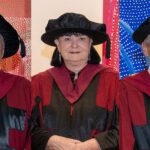The Curtin University-led Murchison Widefield Array (MWA) radio telescope project has been awarded an Australian Research Council (ARC) grant to upgrade its performance by a factor of ten.
The A$1,000,000 grant, part of the ARC Linkage Infrastructure, Equipment and Facilities (LIEF) scheme, announced today by the Minister for Education and Training, Senator the Hon Simon Birmingham, will double the number of telescope antennas to 256 and quadruple the footprint of the MWA to 28 square kilometres.
Professor Steven Tingay, Director of the MWA at Curtin University, said the upgrades would make the telescope ten times more powerful in its exploration of the evolution of the Universe.
“By increasing the number of telescope antennas and the surface area of the MWA, the telescope will strengthen tenfold, like a weightlifter capable of lifting 100kg suddenly being able to lift 1000kg,” Professor Tingay said.
Professor Tingay described the MWA as a ‘time machine’ designed to look back in time more than 12 billion years, to watch the formation of the first stars and galaxies in the Universe, less than one billion years after the Big Bang.
“The MWA has been operating for almost three years and has collected over seven petabytes of data already, the equivalent of almost half a million High Definition movies,” he said.
“With the upgrade that this grant provides, we will able to collect even more and better data, helping to advance our understanding of the last unstudied phase of cosmic evolution.”
An international consortium of 15 organisations from Australia, USA, India, and New Zealand built and operate the MWA, led by Curtin University.
As a result of the new funding, two new organisations will be added to the MWA consortium; The University of Western Sydney and the University of Toronto, Canada, increasing the MWA’s national and international reach.
The MWA is one of three official precursor telescopes for the much larger, billion-dollar scale Square Kilometre Array (SKA) and is the only SKA precursor to be fully operational for science. Half of the SKA will be built at the same site as the MWA, the CSIRO’s Murchison Radio-astronomy Observatory, over the next decade.
Key science, engineering, and computing developments for the SKA are being tested and verified by the MWA, providing critical expertise to the SKA project. This includes working closely with key national initiatives such as the Pawsey Supercomputing Centre.
In the last two years, more than 70 scientific publications have been developed from MWA data. The MWA team also recently won a prestigious award for the telescope’s scientific impact from Thomson Reuters.
For further information on the Murchison Widefield Array visit www.mwatelescope.org or www.facebook.com/Murchison.Widefield.Arrray



